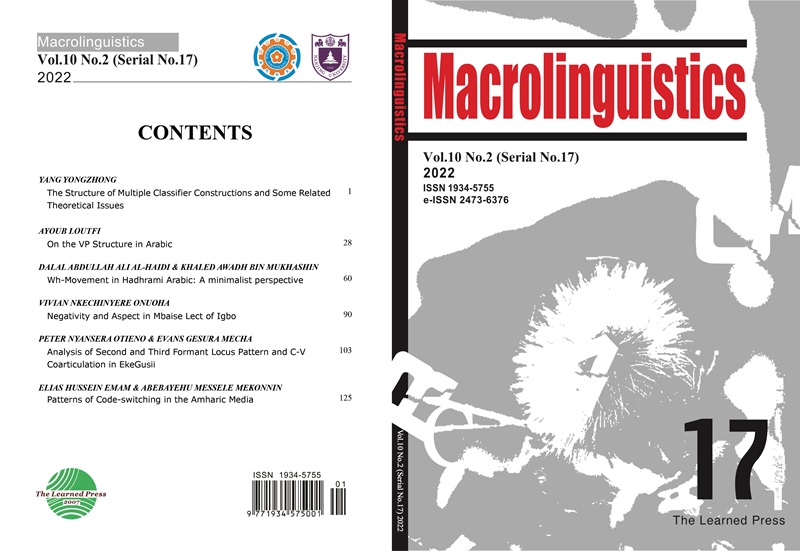Functional Categories in the Arabic DP
引用次数: 0
Abstract
Arabia) Abstract : In this paper, I discuss the basic structure of the determiner phrase in Standard Arabic. I show that this phrase houses three different categories that can project distinct functional heads beside the noun. These categories include: DP, GenP, and NumP. I argue that the noun undergoes cyclic movement to the left of GenP and NumP in order to check its unvalued features. The long-distance probe-goal relation cannot be established in this context due to intervention effects raised by the functional heads. However, the definiteness feature on the DP is valued in-situ, without resorting to movement, hence the appearance of this marker is a prefix on the noun. Thus, a new analysis of the determiner phrase in SA is proposed in terms of cyclic movement and probe-goal relation, where both operations are triggered by unvalued features on the noun. The new analysis can successfully account for the different features on the noun as well as the split of morphological markers on the noun as prefixes and suffixes. I claim that structural nominative/accusative Case on the head noun in the Arabic DP is licensed by higher functional heads, i.e. v and T. However, I argue that the genitive construction in Standard Arabic is mediated by a Poss head that has unvalued features and can license Case. The genitive Case on the complement noun is assigned by the Poss head as a reflex of establishing a probe-goal relation. The proposed position for the Poss head accounts for the inexplicable absence of the definiteness marker on the head noun, as well as the Case morphology mismatch between the head noun and the genitive阿拉伯文DP的功能分类
摘要:本文讨论了标准阿拉伯语中限定词短语的基本结构。我发现这个短语包含三个不同的类别,它们可以在名词旁边投射出不同的功能头。这些类别包括:DP、GenP和NumP。我认为名词在GenP和NumP的左边进行循环运动,以检查其不定值特征。在这种情况下,由于职能负责人提出的干预效应,无法建立远距离探测目标关系。然而,DP上的明确性特征是原位赋值的,而不需要移动,因此该标记的出现是名词上的前缀。因此,从循环运动和探测-目标关系的角度对SA中的限定词短语进行了新的分析,其中这两种操作都是由名词上的不定值特征触发的。新的分析可以成功地解释名词上的不同特征,以及名词上词形标记作为前缀和后缀的分裂。我声称阿拉伯语DP中的头名词上的结构主格/宾格是由更高级的功能头,即v和T许可的。然而,我认为标准阿拉伯语中的属格结构是由具有不值特征并可以许可格的Poss头介导的。补语名词上的属格由波斯语头指定,作为建立探测-目标关系的反射。Poss头的拟议位置解释了头名词上莫名其妙地没有定义标记,以及头名词和属格之间的格形态不匹配
本文章由计算机程序翻译,如有差异,请以英文原文为准。
求助全文
约1分钟内获得全文
求助全文
来源期刊
自引率
0.00%
发文量
83
审稿时长
20 weeks
期刊介绍:
Macrolinguistics (ISSN 1934-5755, e-ISSN 2473-6376) is an international academic journal which is specialized in research papers of non-Indo-European linguistics. It is published biannually by The Learned Press and funded by the Double First-Class Initiative of Nanjing University. It aims at contributing to the complementarity and interaction of linguistic research worldwide.

 求助内容:
求助内容: 应助结果提醒方式:
应助结果提醒方式:


